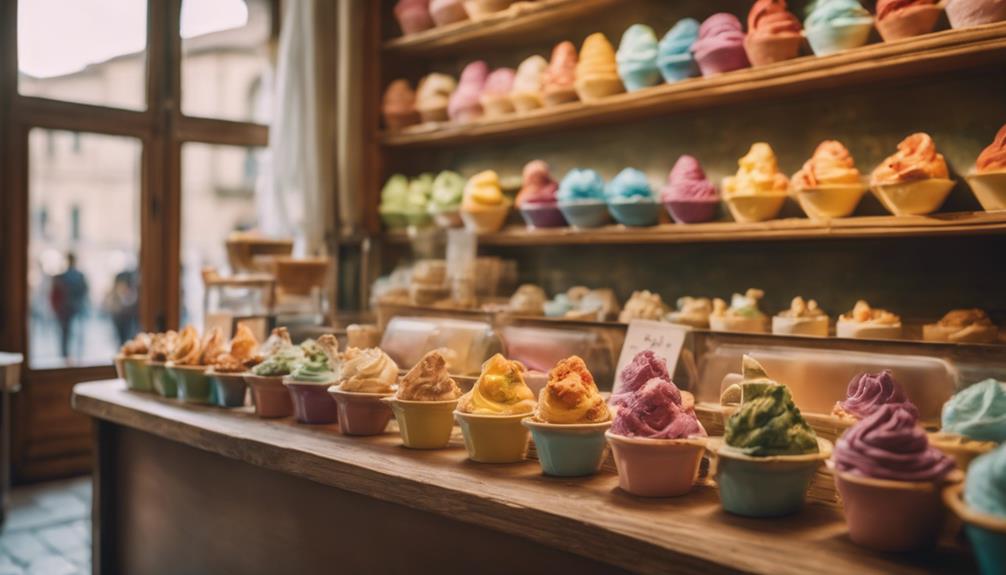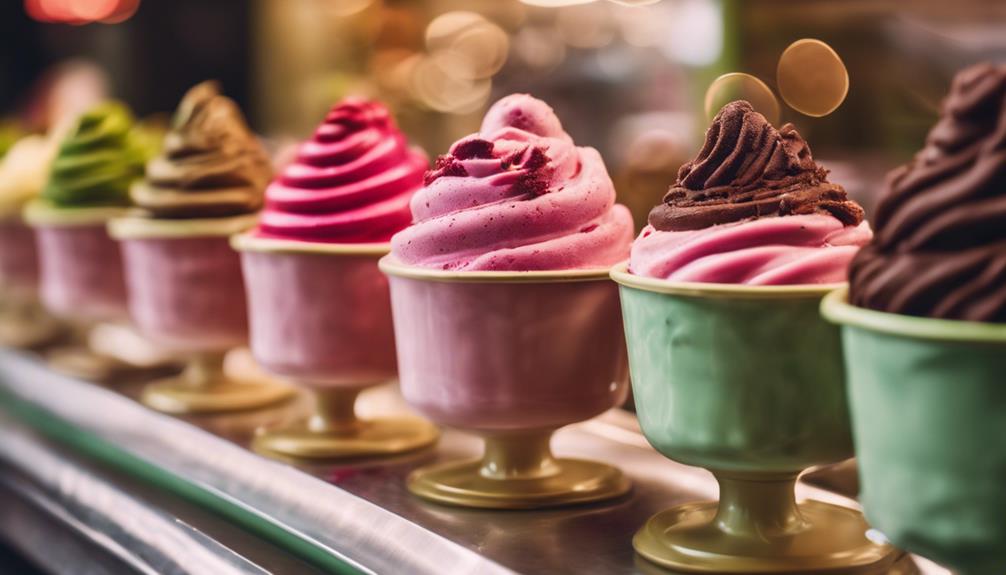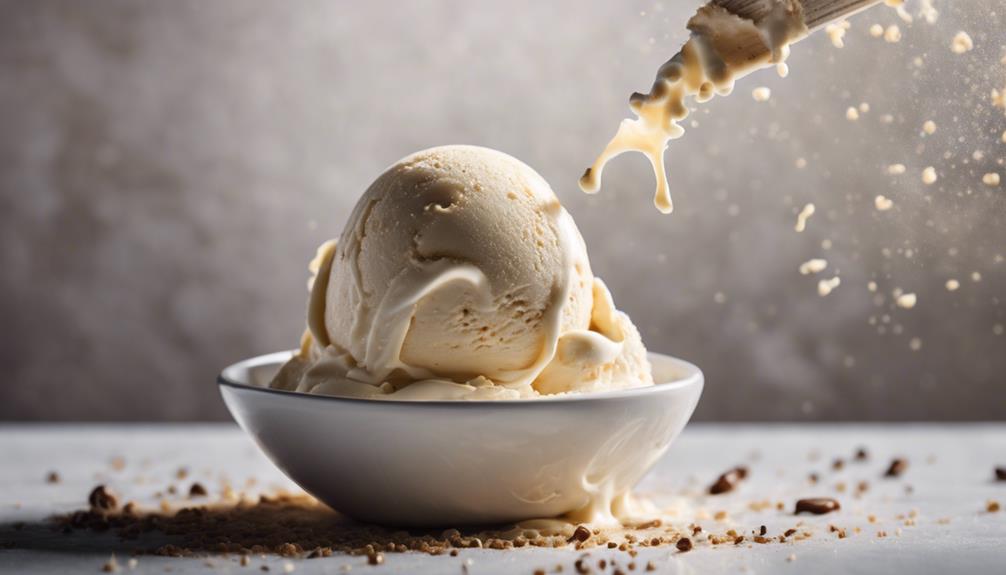When you are searching for the best gelato in Florence, be sure to visit Gelateria La Carraia for its rich flavors. Badiani is known for its famous Buontalenti flavor, which is perfect for a warm day. Don’t forget to stop by Gelateria de Neri for unique combinations. For a taste of history, make sure to visit Vivoli, one of the oldest shops in town. Be sure to try a variety of flavors before making your decision – this will help you find your favorite. Each shop has something unique to offer, and you will soon discover a world of delicious flavors to enjoy. If you want to learn more about these delicious treats, continue reading!
Key Takeaways
- Gelateria La Carraia offers rich flavors and a tasting cone for just 1 euro, making it a must-visit spot.
- Badiani is renowned for its Buontalenti flavor and provides spacious seating for a comfortable experience.
- Gelateria de Neri features an extensive selection of unique and daring flavors, appealing to adventurous palates.
- Look for gelaterias that prioritize high-quality ingredients and seasonal fruits to experience authentic Florentine gelato.
Understanding Gelato and Ice Cream
When you plunge into the world of frozen treats, understanding the differences between gelato and ice cream reveals why gelato's rich, creamy texture and intense flavors make it a beloved choice for many.
Gelato typically contains less fat than ice cream, using more milk and fewer cream, leading to a fat content of 4-9% compared to ice cream's 10-20%. This lower fat content allows the natural ingredients in gelato to shine through, enhancing its flavor profile.
The production process for gelato involves slow churning, which incorporates less air and results in a denser, creamier gelato with fewer air bubbles than ice cream. You'll notice that gelato is generally served at a slightly warmer temperature, which makes the flavors pop even more.
While both frozen delights come in different flavors, gelato often emphasizes natural flavors from fresh fruits and high-quality ingredients, appealing to purists. Additionally, many artisanal gelato shops, or gelato artigianale, create their products without eggs, contributing to the smoother texture and more intense flavor experience you crave.
Understanding these differences will elevate your gelato experience in Florence.
Historical Significance of Gelato

When you think about gelato, remember its roots in the Renaissance period right here in Florence.
This city not only birthed gelato but also shaped it into a cultural icon, often enjoyed by nobility and celebrated at royal courts.
Understanding its historical significance enriches your gelato experience, connecting you to a rich culinary heritage.
Renaissance Origins of Gelato
Originating during the Renaissance, gelato reflects Italy's rich culinary innovations and has become a cherished symbol of Florentine culture. This frozen dessert has roots deeply intertwined with the artistic and culinary advancements of the era. You'll find that Florence is often celebrated as the birthplace of gelato, with many historical gelaterias still operating today. These gelaterias proudly preserve traditional recipes and methods that have been passed down through generations.
The first recorded recipe for gelato is attributed to Francesco Procopio dei Coltelli, a Sicilian innovator who opened the first café in Paris in 1686, helping to popularize this delightful treat across Europe. In Florence, gelato isn't just a dessert; it's an essential part of the local culinary heritage, enjoyed by both locals and tourists alike.
Annual gelato festivals in the city further highlight this rich history, celebrating the artistry of gelato-making while showcasing contemporary culinary innovations. When you savor gelato in Florence, you're not only indulging in a delicious treat but also experiencing a slice of the city's vibrant past and cultural heritage.
Cultural Heritage in Florence
Gelato isn't just a treat in Florence; it represents an essential piece of the city's cultural heritage, deeply woven into its historical narrative.
Originating during the Renaissance, Florence is recognized as the birthplace of gelato, marking its significance in Italy's culinary story. You can explore historical gelato shops like Vivoli, established in 1929, and Perchè No!, operating since 1939, where traditional gelato-making practices have been preserved through generations.
As you stroll through the streets, you'll notice how gelato is celebrated in Florence's culinary culture. Annual festivals honor its rich history and significance, allowing locals and visitors alike to indulge in this delightful dessert while appreciating its roots.
The resilience of gelaterias is evident, having survived historical events like World War II and the 1966 Arno flood, solidifying their status as cultural landmarks.
Top Gelato Shops in Florence

If you're looking to indulge in some of the best gelato Florence has to offer, you won't want to miss these top shops:
- Gelateria La Carraia – Known for its rich, creamy gelato, this shop is a local favorite. Grab a tasting cone for just 1 euro and experience the delightful flavors made with high-quality ingredients.
- Badiani – Famous for its signature Buontalenti flavor, this gelateria has a spacious indoor area and outdoor seating, perfect for enjoying your gelato year-round.
- Gelateria de Neri – Located near Palazzo Vecchio, it boasts an extensive selection of unique flavors, including daring combinations like chocolate with hot chili and rose with gorgonzola.
These gelato shops prioritize high-quality ingredients and often incorporate seasonal fruit into their offerings.
When you visit, you're not just tasting a treat; you're experiencing a piece of Florence's culinary heritage.
Must-Try Gelato Flavors

When you're in Florence, you can't miss out on the must-try gelato flavors that truly capture the essence of Italian dessert culture.
From classic choices like pistachio and stracciatella to unique local variations and seasonal highlights, there's something for every palate.
Let's explore these flavors that will elevate your gelato experience to the next level.
Classic Flavor Recommendations
You can't visit Florence without trying some classic gelato flavors that truly capture the essence of Italian dessert culture. Here are three must-try options:
- Pistachio: This rich flavor, often made with real Sicilian pistachios, delivers a nutty taste that's hard to resist. Look for gelaterie that pride themselves on quality ingredients for the best experience.
- Stracciatella: A fan favorite, Stracciatella combines a creamy vanilla base with delightful chocolate flakes. The mix of smooth and crunchy textures makes it a perfect treat for anyone.
- Tiramisu: Indulge in the gelato version of this iconic Italian dessert. With layers of coffee, mascarpone, and cocoa, Tiramisu gelato is a heavenly experience you won't want to miss.
Don't overlook Fiordilatte, a simple flavor made from just milk and sugar, showcasing the quality of its ingredients.
And if you crave something invigorating, try Lemon Sorbetto—a tangy, dairy-free delight that's perfect for warm days.
Each of these classic flavors brings a unique taste of Italy, making them essential stops on your gelato journey in Florence.
Unique Local Variations
Florence offers a delightful array of unique gelato flavors that reflect the city's rich culinary heritage, making each scoop a memorable experience. When you visit local gelaterias, be sure to indulge in these must-try flavors that showcase the best of Florence's gelato scene.
| Flavor | Description |
|---|---|
| Buontalenti | A creamy blend of milk, sugar, and vanilla, this signature flavor is a must-try at Badiani. |
| Pistachio | Made with real Bronte pistachios, this classic flavor is rich and beloved by both locals and tourists. |
| Limone | This invigorating lemon sorbetto is perfect for hot summer days, made with fresh lemons for a zesty kick. |
Other unique local variations include Stracciatella, which combines creamy vanilla gelato with dark chocolate flakes, and Tiramisu, the gelato version of the beloved dessert, featuring layers of coffee and mascarpone. Each of these flavors offers a creamy or invigorating experience, allowing you to savor the indulgence of Florence's gelato culture. Don't miss out on these extraordinary tastes during your visit!
Seasonal Flavor Highlights
Seasonal gelato flavors in Florence bring a delightful twist to your tasting experience, showcasing the freshest ingredients that each season has to offer.
Embrace the magic of seasonal ingredients with these must-try flavors:
- Summer Seasons: Indulge in invigorating fruit flavors like peach, watermelon, and zesty lemon sorbet. These vibrant tastes are perfect for cooling off during the hot months.
- Winter Favorites: As temperatures drop, savor rich and creamy flavors such as chestnut, chocolate hazelnut, and tiramisu. These comforting options warm you up with every spoonful.
- Limited Edition Flavors: Keep an eye out for unique flavors that pop up during holidays, like pumpkin spice in autumn and decadent chocolate variations around Christmas. They'll make each visit special!
Florentine gelaterias are all about flavor innovations, frequently experimenting with combinations like lime and mint or honeydew with ginger, reflecting local produce availability.
Don't miss out on these seasonal gems; they're a delightful way to experience the essence of Florence throughout the year!
Tips for Choosing Gelato

When hunting for the perfect gelato, keep an eye out for vibrant colors that may signal artificial additives, and instead opt for gelaterias that prioritize natural ingredients.
Look for shops that specialize solely in gelato; they're more likely to offer high-quality, artisanal products made without preservatives.
Don't hesitate to ask for samples before making your decision. Many gelaterias are happy to let you taste different flavors, helping you find your favorite.
Pay attention to the texture as well; good gelato should be smooth and creamy, not overly fluffy or icy. This texture is an indicator of freshness and quality.
When you check out the display, note how the gelato is stored. Gelato kept in stainless steel containers rather than overly high stacks is often a sign of better quality, as it typically contains less air and is fresher.
How to Order Gelato

Ordering gelato is a delightful experience, and knowing how to do it can enhance your enjoyment even more. Here are three key steps to keep in mind:
- Choose your style: Decide between a cup or cone. Cones often offer a larger portion, perfect for hot gelato in the summer.
- Sample flavors: Don't hesitate to ask for samples before you commit. Most gelaterias allow you to try a few flavors, but keep in mind that the number of samples may be limited.
- Know the process: At some places, you'll need to pay first and collect your gelato; at others, you order first and pay later. Always confirm the method at the shop.
And if you're curious about the price, just ask, “Quanto costa?”
Cultural Impact of Gelato

Gelato isn't just a treat in Florence; it's a cultural cornerstone that brings people together and celebrates the city's rich culinary heritage. When you stroll through the streets, you'll find gelaterie in Florence that have stood the test of time, some dating back to the Renaissance. These establishments not only serve delicious frozen desserts but also showcase traditional gelato-making techniques that have been passed down through generations.
Every year, Florence hosts gelato festivals that attract locals and tourists alike, celebrating the art of gelato with a dazzling array of flavors and innovative methods. These events are an indication of the community's love for this beloved dessert, fostering an environment of engagement and collaboration. Many gelaterie actively participate in community engagement through tastings and partnerships with local artisans, strengthening their cultural significance.
The impact of gelato extends beyond Florence; it has inspired countless artisanal gelato shops around the globe to adopt its traditional methods and flavor profiles. This cultural heritage not only enriches the local experience but also connects you to a worldwide appreciation for this exquisite frozen delight.
Seasonal Gelato Variations

Embracing the changing seasons, Florence's gelaterias craft unique flavors that highlight fresh, local ingredients throughout the year. You'll love exploring these seasonal gelato variations:
- Summer Delights: Enjoy fruity flavors like watermelon and peach, perfect for cooling off in the heat.
- Winter Indulgences: Savor creamy flavors such as chestnut and rich chocolate, ideal for colder days.
- Limited Edition Flavors: Don't miss out on seasonal ingredients like pumpkin spice in autumn or festive treats during the Christmas season.
These seasonal gelato variations not only reflect the bounty of Florence's local produce but also enhance your gelato experience.
As the weather shifts, gelaterias invite you to indulge in flavors that resonate with the time of year. With each new season, you can discover creative combinations that celebrate the freshest ingredients, whether you're craving a revitalizing scoop on a hot summer day or a warm, rich gelato in the winter.
Frequently Asked Questions
Where Is the Best Place to Get Gelato in Italy?
When you're searching for the best gelato in Italy, explore local gelaterie. Each region boasts unique flavors and artisanal techniques. Don't hesitate to ask locals for their favorites; they'll guide you to hidden gems!
How Do You Pick Good Gelato in Italy?
When you're choosing gelato in Italy, look for artisan shops. Notice the colors; vibrant means fresh. Try samples, feel the creamy texture, and check the storage bins. Your taste buds will thank you later!
Is Florence Known for Gelato?
Yes, Florence's famous for gelato! You'll discover its rich history, traditional recipes, and artisanal shops showcasing amazing flavors. When you visit, you can't miss experiencing this delightful treat that defines the city's culinary culture.
How Much Does Gelato Cost in Florence, Italy?
In Florence, gelato prices range from €2 to €5, depending on size and location. You can enjoy a small cup for about €2 to €3, while premium flavors might cost more. Tasting cones are a bargain at €1!
Conclusion
When you're in Florence, indulging in gelato isn't just a treat; it's a cultural experience.
Did you know that Italians consume an average of 6 kg of gelato per person each year? This statistic highlights just how integral gelato is to Italian life.
So, as you explore the city and savor the rich flavors, remember that you're partaking in a tradition that dates back centuries.
Enjoy every scoop, and don't hesitate to try something new!









